LEXUS LS430 2006 Owners Manual
Manufacturer: LEXUS, Model Year: 2006, Model line: LS430, Model: LEXUS LS430 2006Pages: 419, PDF Size: 11.19 MB
Page 291 of 419
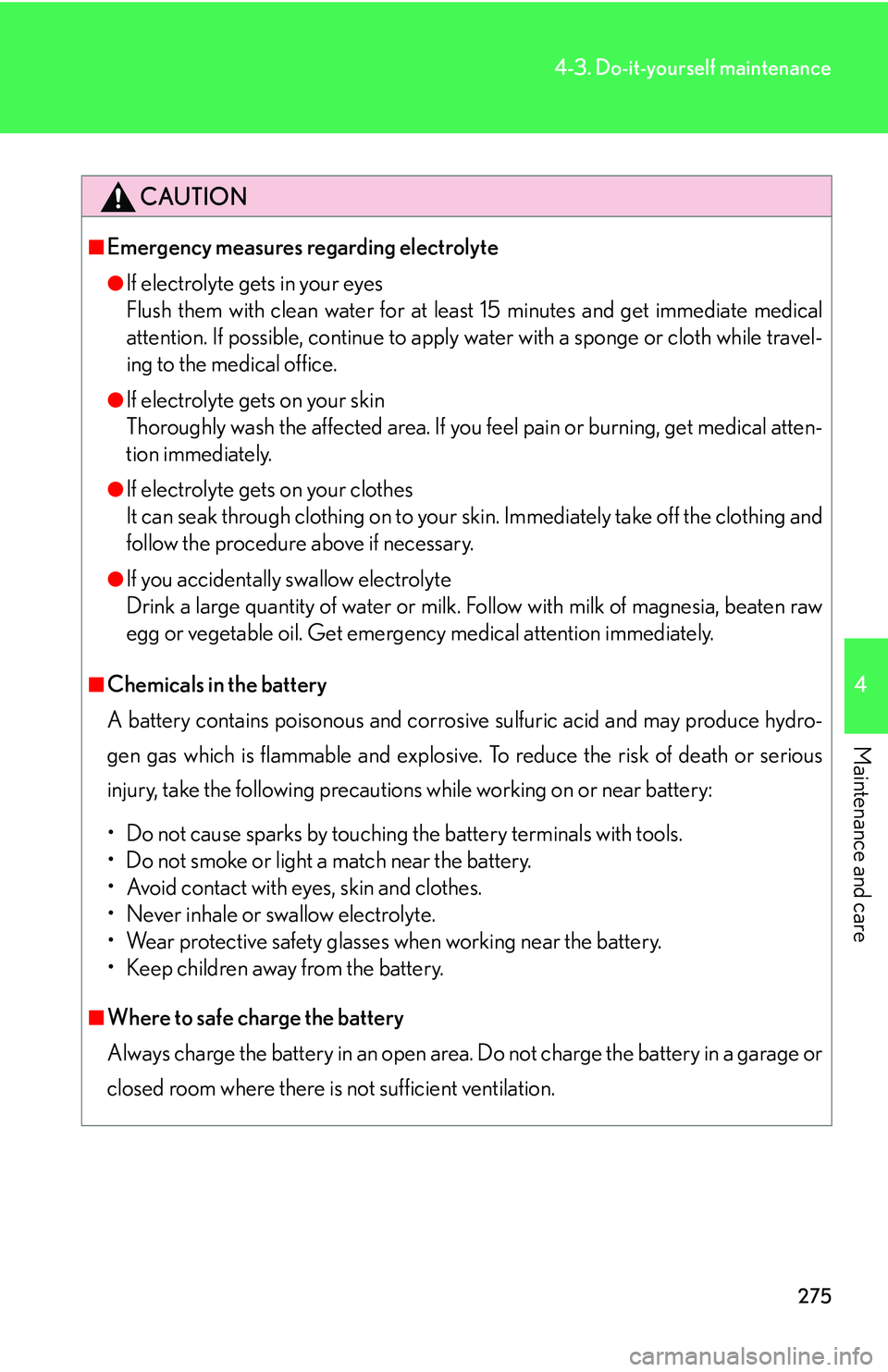
275
4-3. Do-it-yourself maintenance
4
Maintenance and care
CAUTION
■Emergency measures regarding electrolyte
●If electrolyte gets in your eyes
Flush them with clean water for at leas t 15 minutes
and get immediate medical
attention. If possible, continue to apply water with a sponge or cloth while travel -
ing to the medical office.
●If electrolyte gets on your skin
Thoroughly wash the affected area. If you feel p
ain or burning, get medical atten-
tion immediately.
●If electrolyte gets on your clothes
It can seak through clothing on to your skin. Immediat
ely take off the clothing and
follow the procedure above if necessary.
●If you accidentally swallow electrolyte
Drink a large quantity of water or milk. Fo l
low with milk of magnesia, beaten raw
egg or vegetable oil. Get emergency medical attention immediately.
■Chemicals in the battery
A battery contains poisonous and corrosive sulfuric acid and may produce hydro -
gen gas which is flammable and explosive. To reduce the risk of death or serious
injur
y, take the following precautions while working on or near battery:
• Do not cause sparks by touching the battery terminals with tools.
• Do not smoke or light a match near the battery.
• Avoid contact with eyes, skin and clothes.
• Never inhale or swallow electrolyte.
• Wear protective safety glasses when working near the battery.
• Keep children away from the battery.
■Where to safe charge the battery
Always charge the battery in an open area. Do not charge the battery in a garage or
cl
osed room where there is not sufficient ventilation.
Page 292 of 419
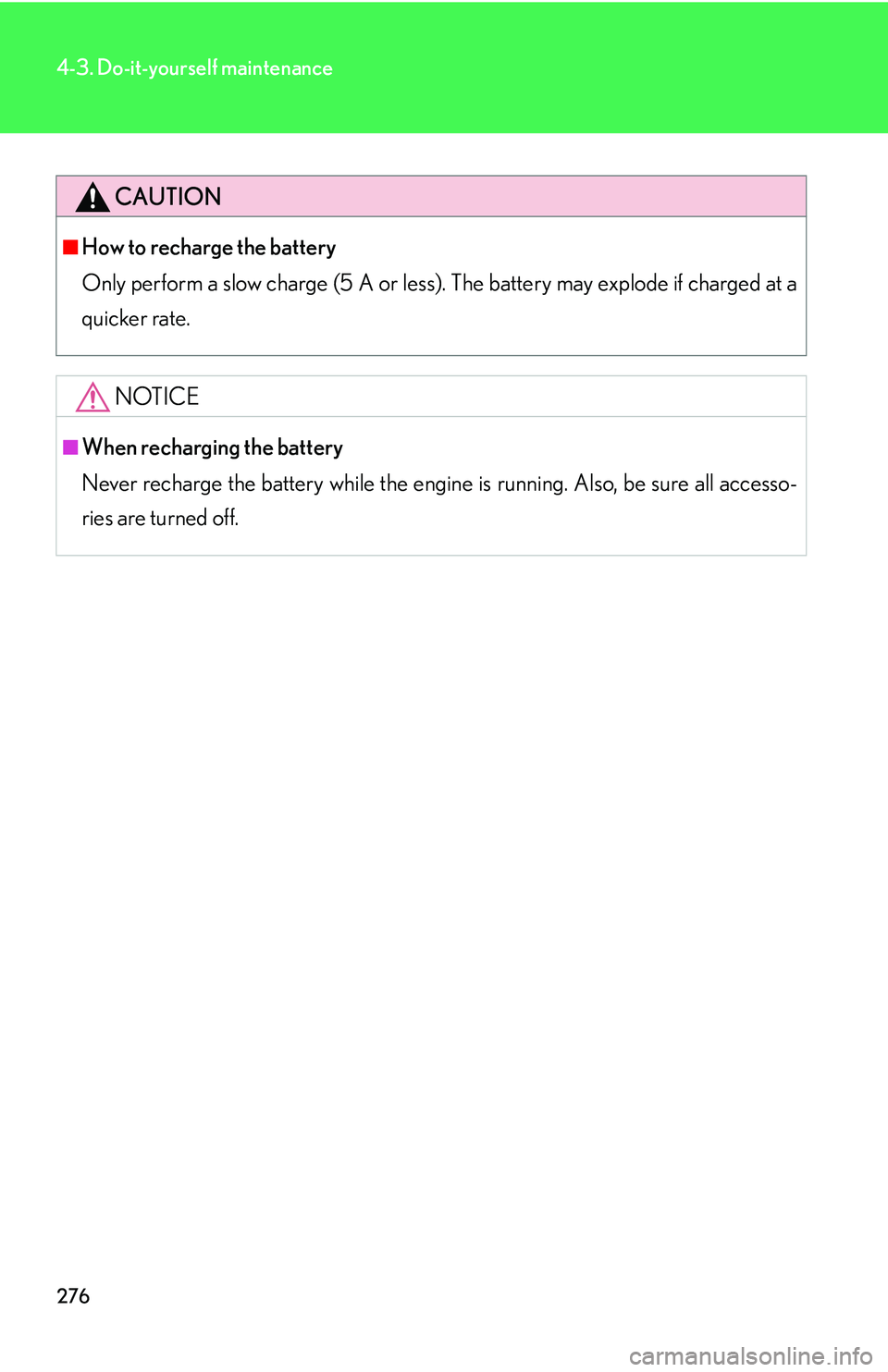
276
4-3. Do-it-yourself maintenance
CAUTION
■How to recharge the battery
Only perform a slow charge (5 A or less). T
he battery may explode if charged at a
quicker rate.
NOTICE
■When recharging the battery
Never recharge the battery while the engine is running. Also, be sure all accesso -
ries are turned off.
Page 293 of 419
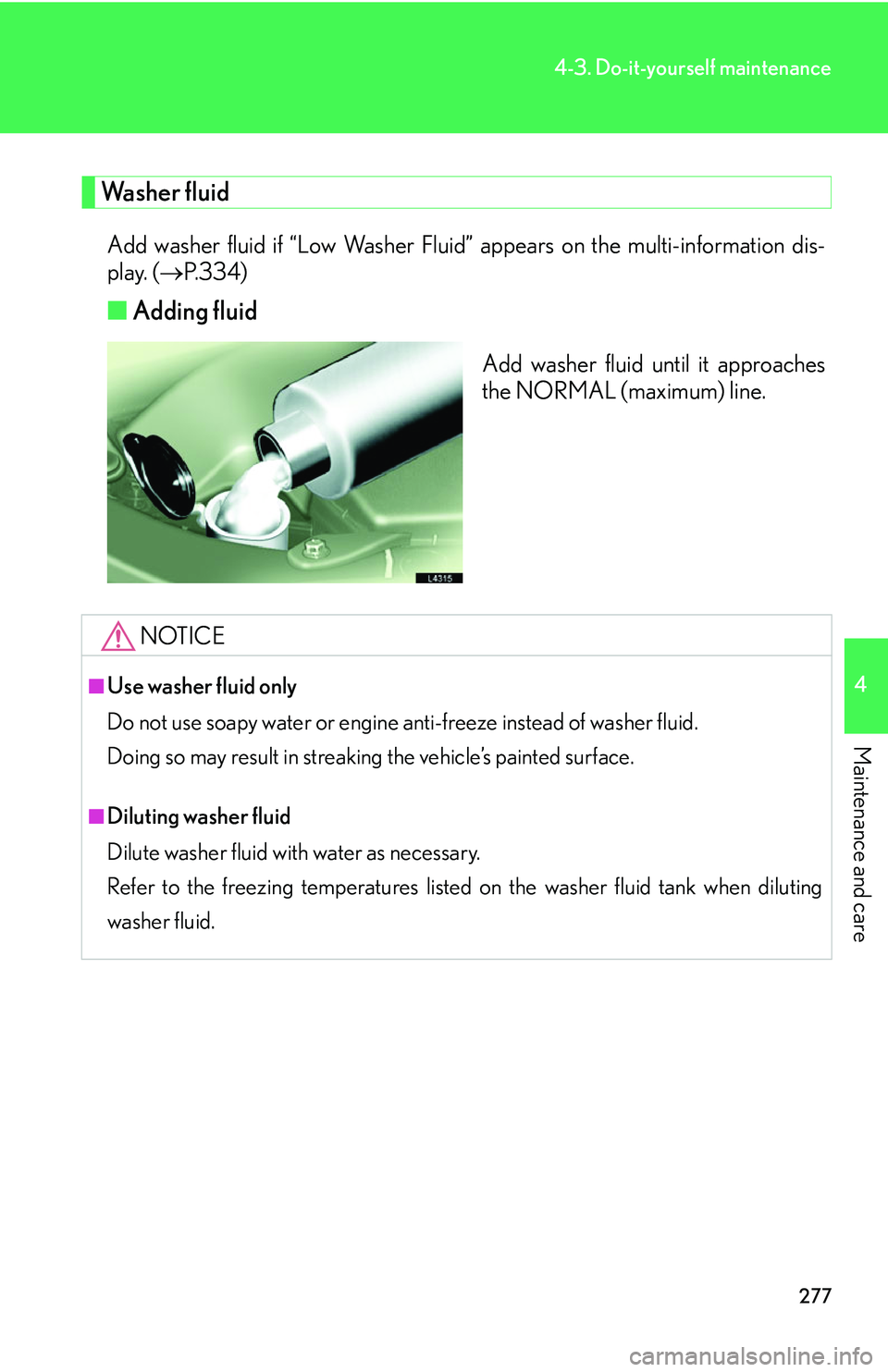
277
4-3. Do-it-yourself maintenance
4
Maintenance and care
Washer fluid
Add washer fluid if “Low Washer Fluid” appears on the multi-information dis-
play. ( P.334 )
■Adding fluid
Add washer fluid until it approaches
the NORMAL (maximum) line.
NOTICE
■Use washer fluid only
Do not use soapy water or engine anti-freeze instead of washer fluid.
Doing so may result in streaking the vehicle’s painted surface.
■Diluting washer fluid
Dilute washer fluid with water as necessary.
Refer to the freezing temperatures listed on the washer fluid tank when diluting
wa
sher fluid.
Page 294 of 419
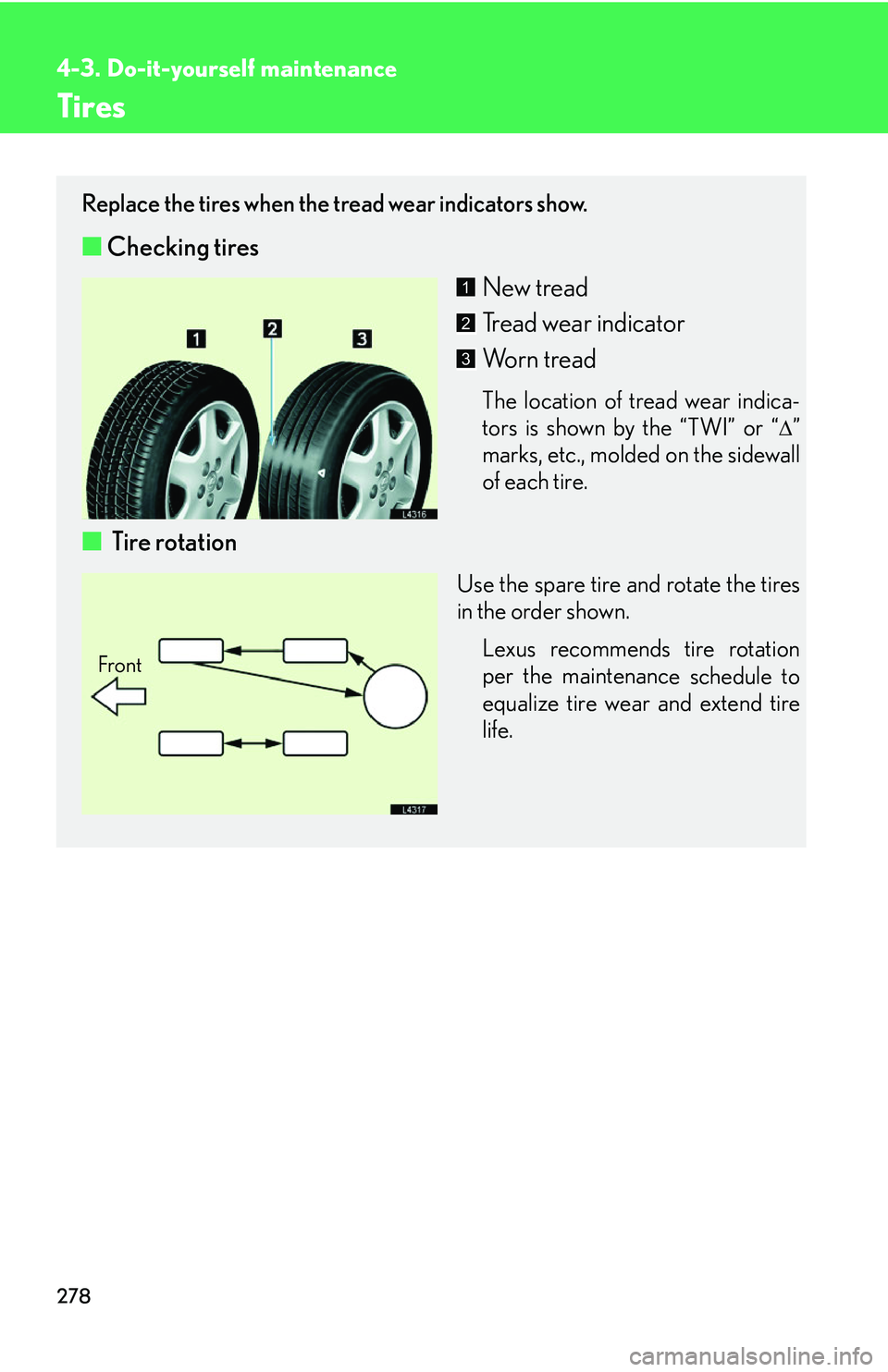
278
4-3. Do-it-yourself maintenance
Tires
Replace the tires when the tread wear indicators show.
■Checking tires
New tread
Tread wear indicator
Worn tread
The location of tread wear indica-
tors is shown by the “TWI” or “
”
marks, etc., molded on the sidewall
of each tire.
■ Tire rotation
Use the spare tire and rotate the tires
in the order shown.
Lexus recommends tire rotation
per the maintenanc
e schedule to
equalize tire wear and extend tire
life.
1
2
3
Front
Page 295 of 419
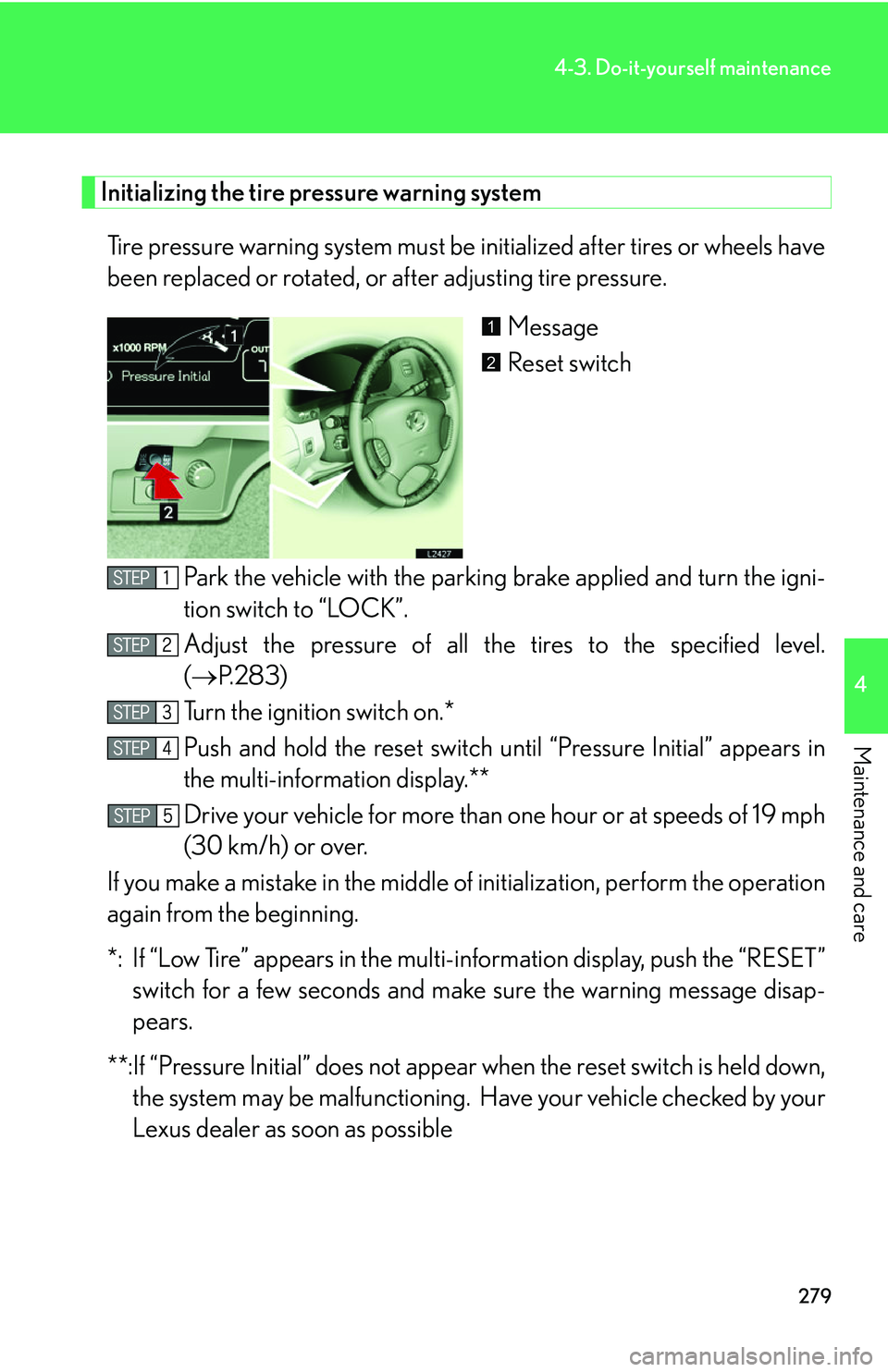
279
4-3. Do-it-yourself maintenance
4
Maintenance and care
Initializing the tire pressure warning system
Tire pressure warning system must be initialized after tires or wheels have
been replaced or rotated, or after adjusting tire pressure.
Message
Reset switch
Park the vehicle with the parking br
ake applied and turn the igni-
tion switch to “LOCK”.
Adjust the pressure of all the tir
es to the specified level.
( P.283 )
Turn the ignition switch on.*
Push and hold the reset switch until “P
ressure Initial” appears in
the multi-information display.**
Drive your vehicle for more than one hour or at speeds of 1
9 mph
(30 km/h) or over.
If you make a mistake in the middle of initialization, per
form the operation
again from the beginning.
*: If “Low Tire” appears in the multi- information display
, push the “RESET”
switch for a few seconds and make sure the warning message disap-
pears.
**:If “Pressure Initial” does not appear when the r
eset switch is held down,
the system may be malfunctioning. Ha ve your vehicle checked by your
Lexus dealer as soon as possible
1
2
Page 296 of 419
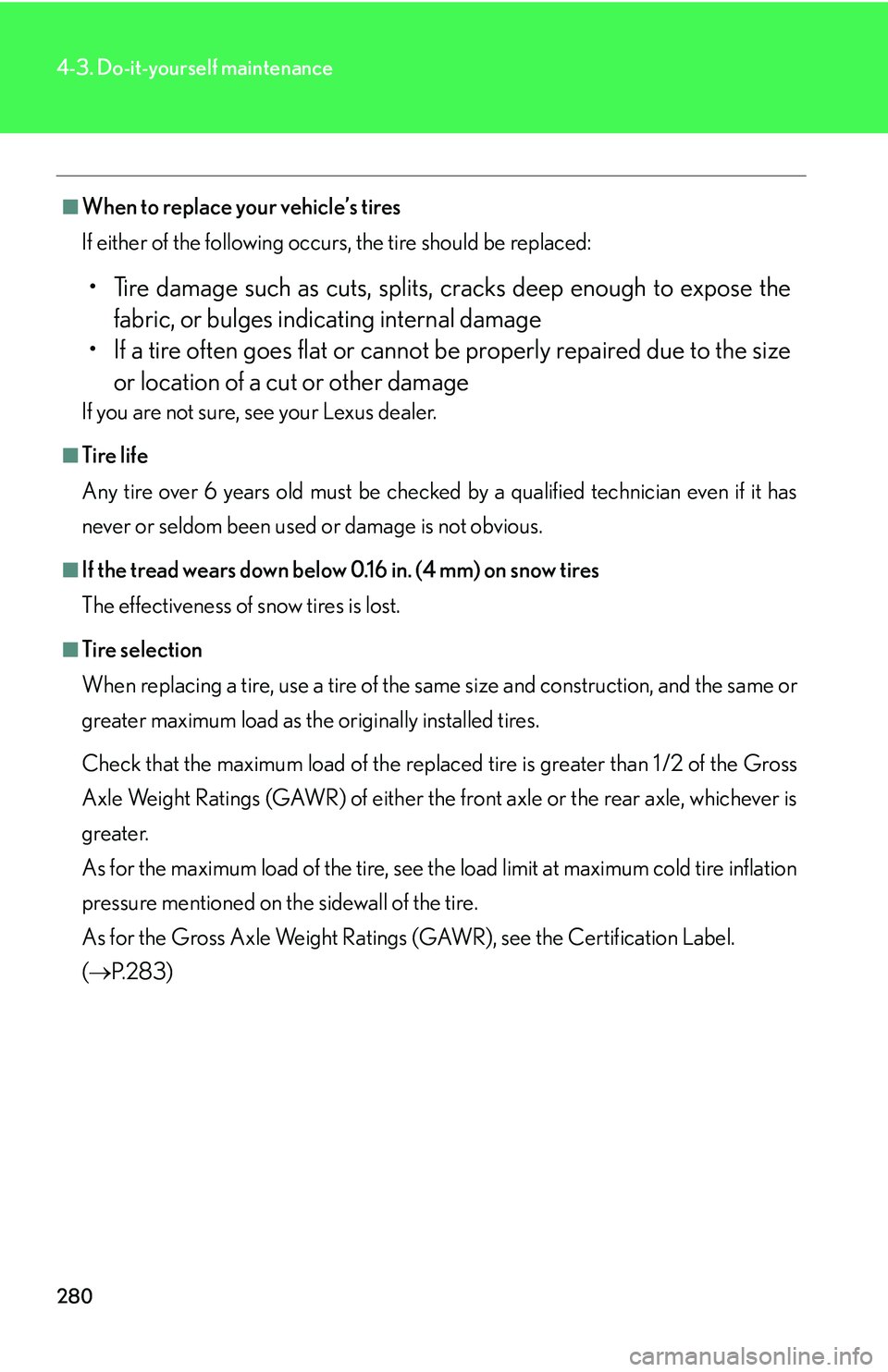
280
4-3. Do-it-yourself maintenance
■When to replace your vehicle’s tires
If either of the following occurs, the tire should be replaced:
• Tire damage such as cuts, splits, cracks deep enough to expose the
fabric, or bulges indicating internal damage
• If a tire often goes flat or cannot be pr
operly repaired due to the size
or location of a cut or other damage
If you are not sure, see your Lexus dealer.
■Tire life
Any tire over 6 years old must be checked by a qualified technician even if it has
ne
ver or seldom been used or damage is not obvious.
■If the tread wears down below 0.16 in. (4 mm) on snow tires
The effectiveness of snow tires is lost.
■Tire selection
When replacing a tire, use a tire of the sa me siz
e and construction, and the same or
greater maximum load as the originally installed tires.
Check that the maximum load of the replaced t
ire is greater than 1 /2 of the Gross
Axle Weight Ratings (GAWR) of either the front axle or the rear axle, whichever is
greater.
As for the maximum load of the tire, see the load limit a
t maximum cold tire inflation
pressure mentioned on the sidewall of the tire.
As for the Gross Axle Weight Ratings (GAWR), see the Certification Label.
( P.283 )
Page 297 of 419
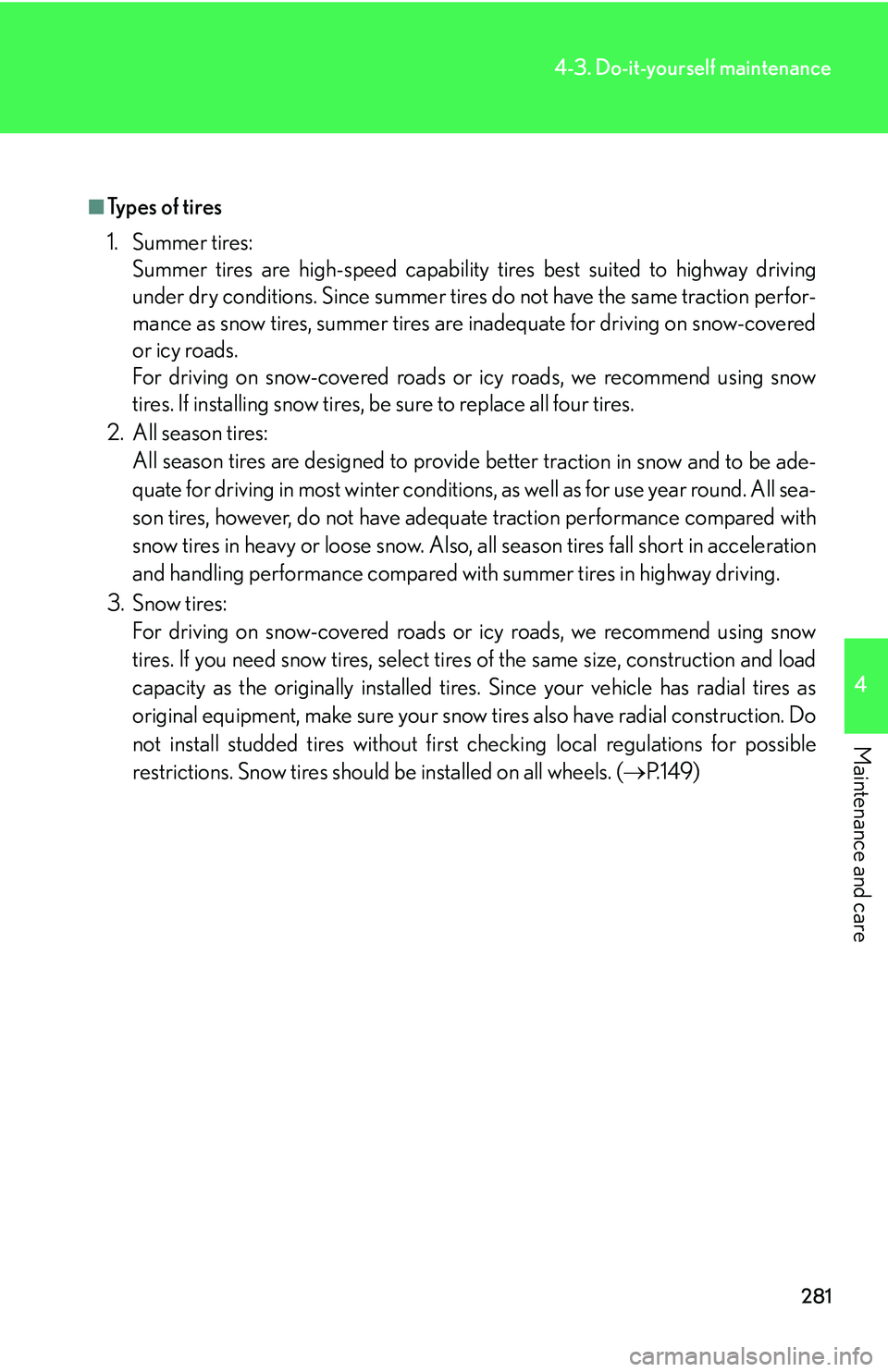
281
4-3. Do-it-yourself maintenance
4
Maintenance and care
■Ty p e s o f t i r e s
1. Summer tires:
Summer tires are high-speed capability tires best suited to highway driving
un
der dry conditions. Since summer tires do not have the same traction perfor-
mance as snow tires, summer tires are in adequate f
or driving on snow-covered
or icy roads.
For driving on snow-covered roads or icy roads, we recommend using snow
t
ires. If installing snow tires, be sure to replace all four tires.
2. All season tires:
All season tires are designed to provid e better tr
action in snow and to be ade-
quate for driving in most winter conditions , as
well as for use year round. All sea-
son tires, however, do not have adequa te
traction performance compared with
snow tires in heavy or loose snow. Also, a ll season tires fall short in acceleration
and handling performance compared wi th summer tires in highway driving.
3. Snow tires:
For driving on snow-covered roads or icy roads, we recommend using snow
tir
es. If you need snow tires, select tire s of the same size, construction and load
capacity as the originally installed tires. Since your vehicle has radial tires as
original equipment, make sure your snow tires also have radial construction. Do
not install studded tires without first checking local regulations for possible
restrictions. Snow tires should be installed on all wheels. (P.149 )
Page 298 of 419
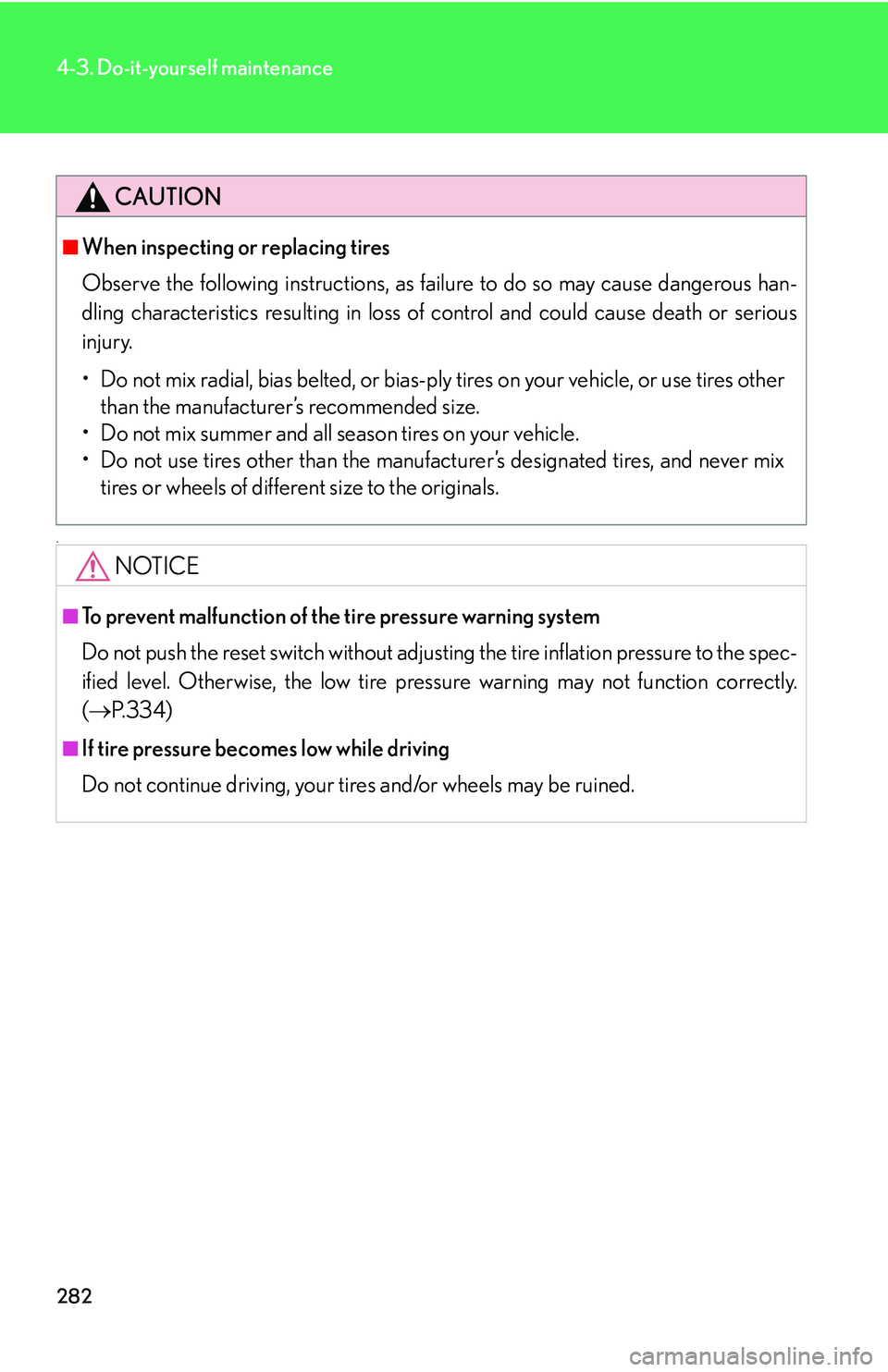
282
4-3. Do-it-yourself maintenance
+
CAUTION
■When inspecting or replacing tires
Observe the following instructions, as failure to do so may cause dangerous han-
dling characteristics resulting in loss of contr
ol and could cause death or serious
injury.
• Do not mix radial, bias belted, or bias-ply tir
es on your vehicle, or use tires other
than the manufacturer’s recommended size.
• Do not mix summer and all season tires on your vehicle.
• Do not use tires other than the manufact ur
er’s designated tires, and never mix
tires or wheels of different size to the originals.
NOTICE
■To prevent malfunction of the tire pressure warning system
Do not push the reset switch without adjusting the tire inflation pressure to the spec-
ified level. Otherwise, the low tire pressure warning may not function correctly.
( P.334 )
■If tire pressure becomes low while driving
Do not continue driving, your ti r
es and/or wheels may be ruined.
Page 299 of 419
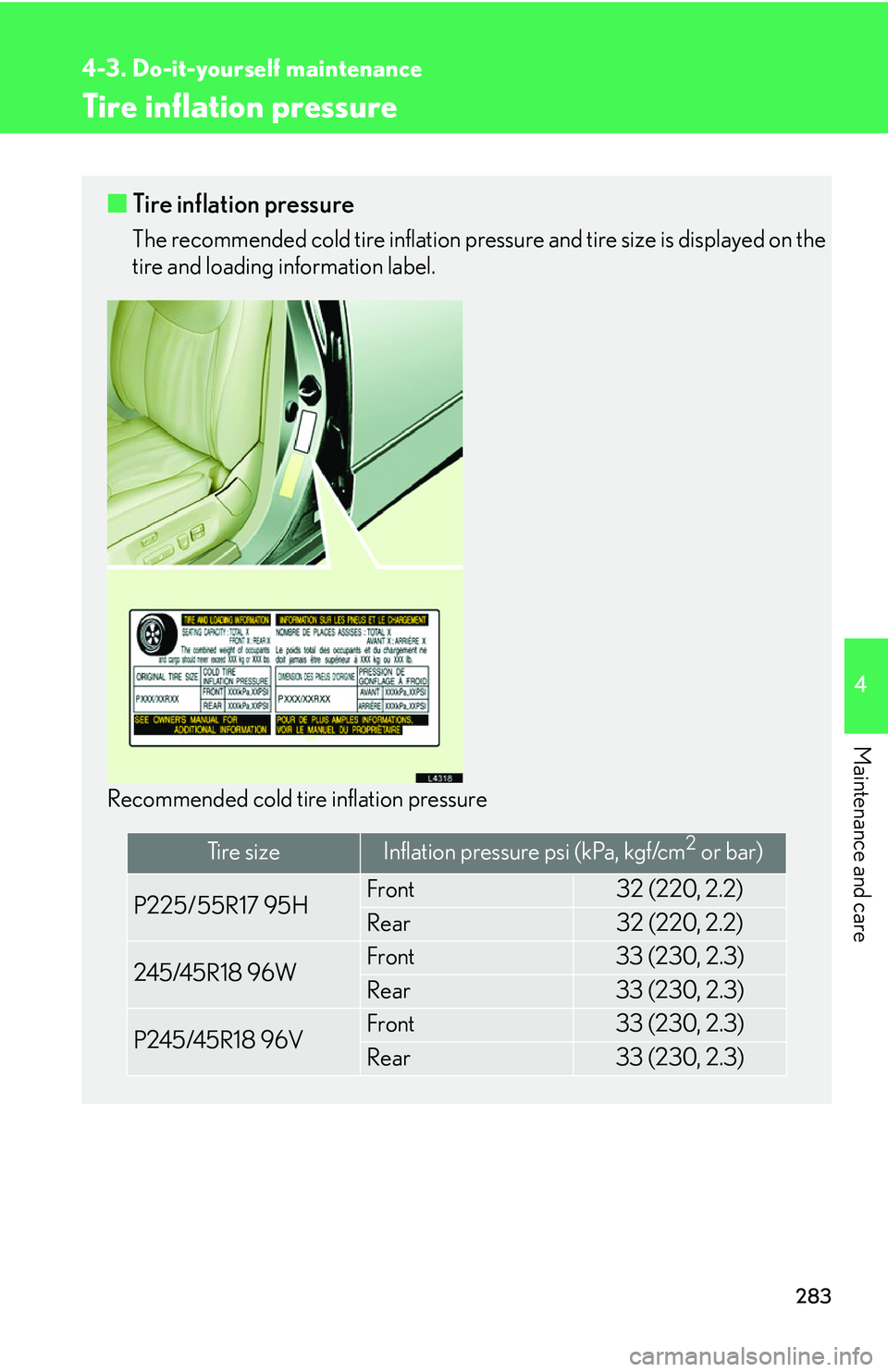
283
4-3. Do-it-yourself maintenance
4
Maintenance and care
Tire inflation pressure
■Tire inflation pressure
The recommended cold tire inflation pressure and tire size is displayed on the
tire and loading information label.
Recommended cold tire inflation pressure
Ti r e s i z eInflation pressure psi (kPa, kgf/cm2 or bar)
P225/55R17 95HFront32 (220, 2.2)
Rear32 (220, 2.2)
245/45R18 96WFront33 (230, 2.3)
Rear33 (230, 2.3)
P245/45R18 96VFront33 (230, 2.3)
Rear33 (230, 2.3)
Page 300 of 419
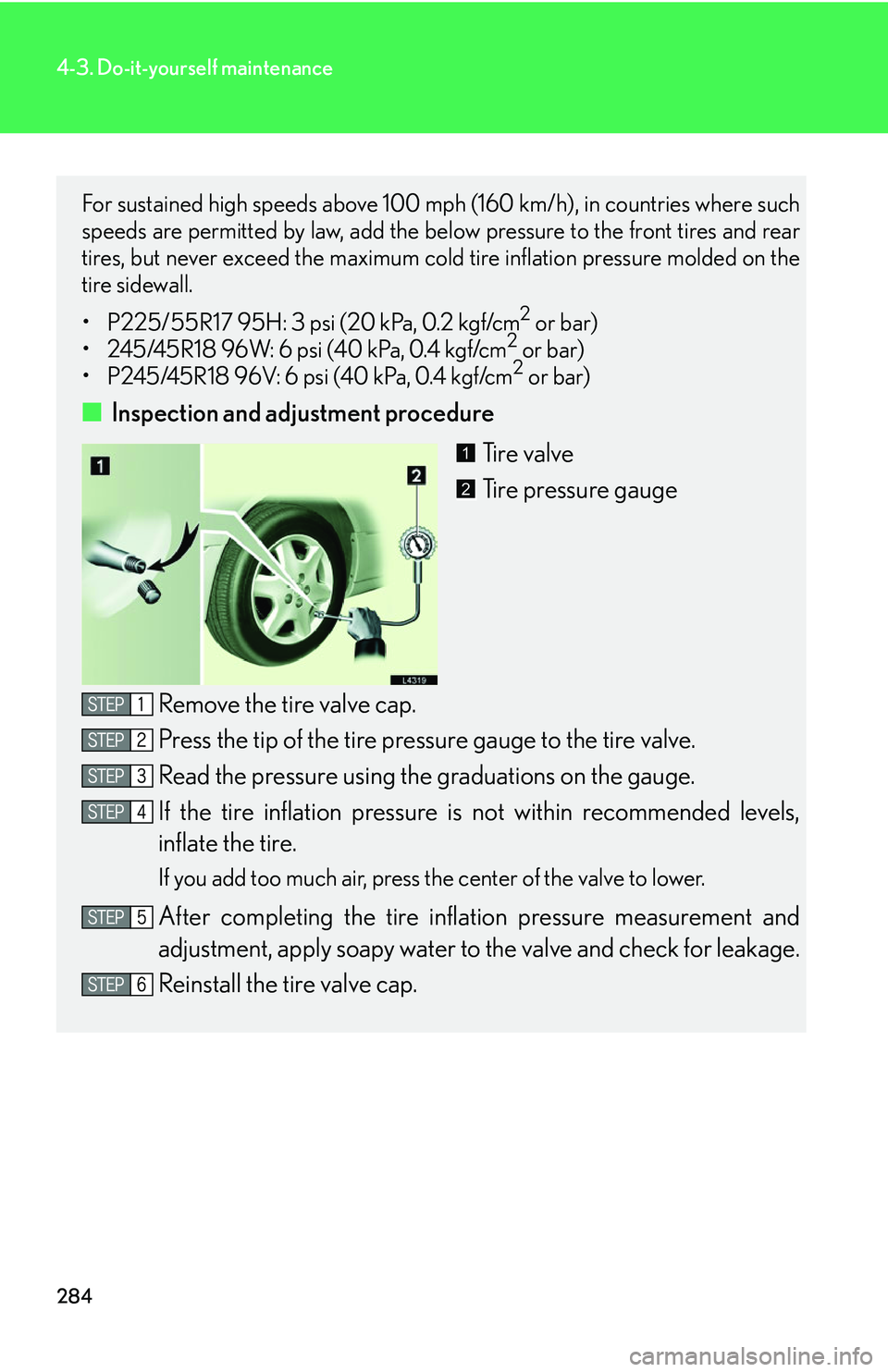
284
4-3. Do-it-yourself maintenance
For sustained high speeds above 100 mph (160 km/h), in countries where such
speeds are permitted by law, add the below pressure to the front tires and rear
tires, but never exceed the maximum cold tire inflation pressure molded on the
tire sidewall.
• P225/55R17 95H: 3 psi (20 kPa, 0.2 kgf/cm2 or bar)
• 245/45R18 96W: 6 psi (40 kPa, 0.4 kgf/cm2 or bar)
• P245/45R18 96V: 6 psi (40 kPa, 0.4 kgf/cm2 or bar)
■ Inspection and adjustment procedure
Ti r e v a l v e
Tire pressure gauge
Remove the tire valve cap.
Press the tip of the tire pressure gauge to the tire valve.
Read the pressure using the graduations on the gauge.
If the tire inflation pressure is not within r
ecommended levels,
inflate the tire.
If you add too much air, press the center of the valve to lower.
After completing the tire inflation pressure measurement and
adjustment, apply soapy water to the v
alve and check for leakage.
Reinstall the tire valve cap.
1
2